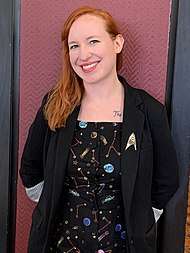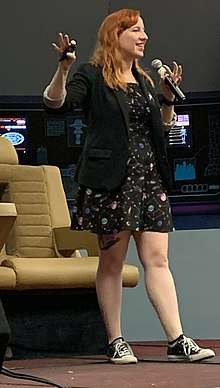Erin Macdonald
Erin Macdonald is an astrophysicist, aerospace engineer, and science fiction consultant. She hosts the YouTube channel, Dr. Erin Explains the Universe, teaches STEM through popular culture, and consults with science fiction creators.[1][2]
Erin Patricia Macdonald | |
|---|---|
 Macdonald in 2019 | |
| Education | B.A., Physics with Astrophysics B.A., Mathematics Ph.D., Astrophysics |
| Alma mater | University of Colorado Boulder University of Glasgow |
| Known for | Science communication Science fiction consultation |
| Home town | Los Angeles, California |
| Scientific career | |
| Fields | Astrophysics Gravitational waves Aerospace engineering |
| Institutions | SAIC |
| Thesis | From Upper Limits to Detection: Continuous Gravitational Waves in the Advanced Detector Era (2012) |
| Doctoral advisors | Graham Woan Ik Siong Heng |
| Website | www |
Education and early career
Macdonald credits fictional characters such as Dana Scully and Kathryn Janeway (the latter of whom she even acknowledges in her Ph.D. dissertation)[3] with providing the inspiration to pursue a science career.[4] She earned her bachelor's degrees in astrophysics and mathematics at the University of Colorado Boulder (after transferring there from the University of New Mexico) and her Ph.D. at the University of Glasgow, where she concentrated in general relativity.[5]
Macdonald did post-doctoral work with the Laser Interferometer Gravitational-Wave Observatory (LIGO) collaboration as part of an attempt to detect gravitational waves from the Crab Pulsar.[1] She also did post-doctoral work at Cardiff University, still with LIGO,[1] where she was the first female researcher in her department.[2] During this period she became involved with the Actors Workshop, in Cardiff,[6] which she credits with helping her efforts at science communication. Macdonald's first job after leaving academia was at the Denver Museum of Nature and Science. She also began teaching at local community colleges and eventually found work analyzing data in the aerospace industry.[4][5]
Science communication

While searching for a better work-life balance than that provided in research and academia, Macdonald found opportunities to still teach through a combination of conducting introductory courses and speaking at science fiction conventions. She would discover that these activities put her “in front of students and kids who may find inspiration in a punk-redhead woman covered in tattoos who also happens to have a PhD.”[5] After deciding not to pursue an academic research career, Macdonald began giving talks at science fiction conventions in the areas of her expertise that link the science to the various fandoms of her audience members. For example, she has used Voltron: Legendary Defender to teach about spacetime.[5] She has made appearances at such conventions as Awesome Con and Dragon Con.[1] This led her to meeting and working with science fiction writers in the entertainment industry.[7]
Science fiction consultation
Macdonald moved to Los Angeles from Colorado and works with writers and producers in Hollywood to bring scientific accuracy to their productions. She has, for example, served as technical consultant on several episodes of Orbital Redux.[5][8] In 2019, Macdonald produced a Great Courses course on the science of science fiction via Audible.[9]
In late 2019, Macdonald became a science consultant for Star Trek. She would work with producers and writers throughout the Star Trek franchise.[10]
References
- Baldwin, Melinda (2019). "Q&A: Astrophysicist Erin Macdonald on Science and Sci-Fi". Physics Today. doi:10.1063/pt.6.4.20190509a.
- Hazzard, Tracy Leigh (May 4, 2019). "Black Holes, Hollywood, and Astrophysics: May the Fourth Be With You". Inc. Archived from the original on October 19, 2019. Retrieved October 19, 2019.
- Macdonald, Erin (2012). From Upper Limits to Detection: Continuous Gravitational Waves in the Advanced Detector Era (PDF) (PhD). University of Glasgow. Retrieved October 19, 2019.
- Abrams, Michael. "Erin Macdonald: Role Models and Communicating the Universe". ASME E-Fests. Archived from the original on October 19, 2019. Retrieved October 19, 2019.
- Rupp, Jacob (February 2019). "Making the science in science fiction come alive, with astrophysicist Dr Erin Macdonald and Rabbi Jacob Rupp". Authority Magazine. Archived from the original on October 19, 2019. Retrieved October 19, 2019.
- Krishna, Swapna (August 17, 2017). "Astrophysicist Erin Macdonald on the Science of Sci-Fi and Fictional Mentors". SYFY. Archived from the original on October 21, 2019. Retrieved October 21, 2019.
- Sodini, Jennifer (July 10, 2019). "Putting the "Science" in Science Fiction with Dr. Erin Macdonald". Face the Current. Retrieved October 19, 2019.
- "Erin Macdonald". IMDB.
- "Another One with Erin Macdonald". Mission Log Live. December 4, 2019. Retrieved December 7, 2019.
- "Weekly Space Hangout". YouTube. Retrieved January 17, 2020.